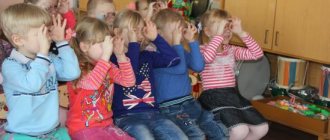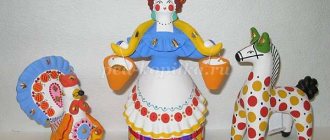(games of the peoples of Siberia and the Far East)
The players stand in pairs, facing each other and clap their hands, saying:
Cold floes, Transparent floes,
They sparkle, ring, ding, ding...
They clap for every word: first with their own hands, then with a friend. They clap their hands and say ding, ding until they hear the signal “Wind!” The ice children scatter in different directions and agree on who will build a circle with whom - a large piece of ice. At the signal “Frost!” everyone lines up in a circle and joins hands.
Rules of the game. Those children who have more players in the circle win. It is necessary to negotiate quietly about who will build a large ice floe with whom. Those who agree join hands. You can change movements only on the signal “Wind!” or “Frost!” It is advisable to include different movements in the game: hopping, light or fast running, side gallop, etc.
Falcon and Fox (Yakut folk game)
A falcon and a fox are chosen. The rest of the children are falcons. The falcon teaches his falcons to fly. He easily runs in different directions and at the same time makes various flying movements with his hands (up, to the sides, forward) and also comes up with some more complex movement with his hands. A flock of falcon chicks runs after the falcon and watches its movements. They must exactly repeat the movements of the falcon. At this time, a fox suddenly jumps out of the hole. The falcons quickly squat down so that the fox does not notice them.
Rules of the game. The time of the fox's appearance is determined by the leader's signal. The fox only catches those who have not crouched.
"Folk outdoor games in preschool educational institutions"
- February 3, 2014
Competition “My Pedagogical Initiative - 2013”
Nomination “Methodological work in preschool educational institutions”
“Give children more and more general, human, world content, but mainly try to introduce them to this through native and national phenomena.” V. Belinsky.
Today we are beginning to look at many things differently, we are rediscovering and re-evaluating many things, this relates to the past of our people. Unfortunately, most people are very superficially familiar with Russian folk art. The native culture should become an integral part of the child, the beginning that gives rise to personality. You need to start introducing folk art from preschool age and best of all through play.
Tasks:
- introduce children to Russian folk art (games, counting rhymes),
- develop interest in the history of folk culture and folklore.
Our childhood is directly connected with the game. Children love to play various games, but most of all they love outdoor games. There are different types of outdoor games: plot-based and plot-free. But I would like to talk separately about folk outdoor games.
Folk games are accessible to children in their content. In the game, children improve their physical abilities and skills, increase motor activity, and develop physical qualities. Through folk games, children expand their horizons and gain ideas about the world around them. The rules of these games have great educational significance. They determine the entire course of the game, regulate the actions and behavior of children, and their relationships.
Folk games are often accompanied by funny moments, children’s favorite counting rhymes, drawing lots, and nursery rhymes, which have great aesthetic significance and constitute the most valuable, unique gaming folklore. So, for example, the beginnings are like a game prelude, they make it possible to quickly organize the players, set them up for an objective choice of the leader, unconditional compliance with the rules. In addition to counting rhymes, there are draws, which also create an emotional mood and captivate the game itself.
Clear counting rhymes, melodious and funny sing-alongs, entertaining dialogues are quickly and firmly remembered and are spoken with pleasure by children in their everyday games. Folklore is passed down orally from generation to generation and never grows old.
The teacher, creatively using the game as an emotional and imaginative means of influencing children, awakens their interest and imagination, achieving active performance of game actions. During the game, the teacher attracts the children’s attention to its content, monitors the accuracy of movements that must comply with the rules, the dosage of physical activity, gives brief instructions, supports and regulates the emotionally positive mood and relationships of the players, teaches them to act deftly and quickly in the created game situations, provide comradely support, achieve a common goal and experience joy at the same time.
The teacher should remember that his main task is to teach children to play actively and independently. Only in this case will they learn to regulate the degree of attention and muscle tension in any game situation, adapt to changing environmental conditions, find a way out of a critical situation, quickly make a decision and carry it out, show initiative, i.e. preschoolers acquire important qualities they need in the future.
Folk outdoor games in combination with other educational means represent the initial stage of the formation of a harmoniously developed, active personality, combining spiritual wealth, moral purity and physical perfection. When working with children, the teacher must remember that childhood impressions are deep and indelible in the memory of an adult. They form the foundation for the development of his moral feelings, consciousness and their further manifestation in socially useful and creative activities.
In the practice of preschool education, folk games are rare.
I believe that the proposed scenario will be of practical interest to those who want to expand children’s understanding of folk art. The task of the teacher and parents, or rather, their sacred duty, is to teach them to love their Motherland.
Physical education leisure for senior preschool age.
Lesson summary. Russian folk games.
Author: Kotova Elena Leonidovna, physical education instructor, MBDOU kindergarten No. 16 “Alenka”, Spassk-Dalniy, Primorsky Territory.
Tug of war with sticks (Yakut folk game)
The players, divided into two groups, sit on the floor in single file: one group against the other. The front ones grab the stick with both hands and rest their feet against each other. The others in each group hold each other tightly by the waist. On command, they gradually pull each other over.
Rules of the game. The winner is the group that pulled another group to its side, or raised several people in it from their seats, or snatched the stick from the hands of the one in front. The players on each team must be equal in number and strength.
Moon or sun (Chuvash folk game)
Two players are chosen to be captains. They agree among themselves which of them is the moon and which is the sun. The others, who had previously been standing aside, approach them one by one. Quietly, so that others do not hear, everyone says what he chooses: the moon or the sun. They also quietly tell him whose team he should join. So everyone is divided into two teams, which line up in columns - the players behind their captain, clasping the person in front by the waist. Teams pull each other across the line between them. The tug-of-war is fun and emotional, even when the teams are unequal.
Rules of the game. The loser is the team whose captain crossed the line during the tug-of-war.
Kick the ball out (Russian folk game)
Two horse lines are marked on opposite sides of the site. The distance between them is 5 - 10 m.
The players are divided into two teams and stand opposite each other behind the lines. By lot, one of them starts the game. Children take turns sending the ball towards their opponents with a strong kick. They try not to let the ball go beyond the line and kick it back. If the ball does not reach the stake line, then the players pass it with their hands. So the ball passes from team to team until it passes the line. A player who misses the ball is penalized (any object is placed behind him). The team with the fewest penalty points wins.
Rules of the game. When meeting the ball, the player can go beyond the end line only one step. If the ball is sent weakly and does not reach the end, the player is also fined.
Herd (Russian folk game)
The players choose a shepherd and a wolf, and everyone else chooses sheep. The wolf's house is in the forest, and the sheep have two houses at opposite ends of the site. The sheep loudly call the shepherd: Shepherd, shepherd,
Play the horn! The grass is soft
Sweet dew. Drive the herd into the field
Take a walk in freedom!
The shepherd drives the sheep out into the meadow; they walk, run, jump, and nibble grass. At the shepherd’s signal: “Wolf!” - all the sheep run into the house on the opposite side of the site. The shepherd stands in the way of the wolf and protects the sheep. Everyone caught by the wolf leaves the game.
Rules of the game. During the run, sheep should not return to the house from which they left. The wolf does not catch the sheep, but kills them with his hand. The shepherd can only shield the sheep from the wolf, but should not hold it back with his hands.



